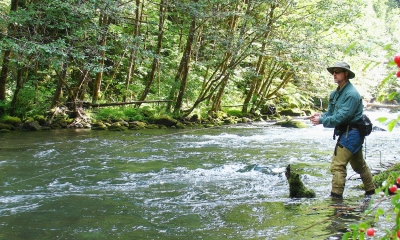
Warmwater fishing on the north coast
The north coast area includes the Lower Columbia River downstream of St. Helens to the Pacific Ocean, and the Oregon Coast from Astoria south to Yachats. The Columbia, and particularly its backwaters and sloughs, provide excellent fisheries for bass, crappie, and catfish.

Good locations for young or beginning anglers and families include Cullaby Reservoir located midway between Warrenton and Seaside and Vernonia Pond near the small town of Vernonia. As you head south along the coast, try fishing for bass at Lake Lytle near Rockaway Beach or bass and catfish at Olalla Lake just east of Newport. Other warmwater fish available in the south coast area include: Largemouth Bass | Smallmouth Bass | Bullheads | Black Crappie | Bluegill | Pumpkinseed | Yellow Perch | Green Sunfish | Warmouth | Channel Catfish | Walleye
Featured waterbody - Cullaby Lake
Located just off Hwy 101 on the northern Oregon coast between Astoria and Seaside, Cullaby is a long and narrow 220 acre lake that offers a good warmwater fishing opportunity for local and vacationing anglers. It supports a variety of fish including crappie, bluegill, yellow perch, brown bullhead catfish, and an abundance of nice-sized largemouth bass that attracts tournament anglers in the spring. It is also a great location for young anglers and families as there are two county parks, picnic shelters, play areas, beaches, docks, and opportunities for swimming. During the summer, anglers share the lake with water and jet skiers, but the shoreline, alcoves, and the northern end of the lake near Carnahan County Park, and the southern end near the mouth of Cullaby Creek are off-limit to high-speed boat use and offer good fishing. Aquatic weeds can get to be a problem in some areas so a boat will make access easier later in the summer. Ramps are located at Carnahan and Cullaby Lake County Parks.
Cullaby is fairly shallow with an average depth of less than 12 feet, but the brush along the banks and submerged wood debris and vegetation provide excellent fish habitat. Warmwater fish have done well in Cullaby after they were introduced, particularly the yellow perch and crappie, and there has been no need for stocking. Rainbow trout are stocked annually to provide a seasonal fishery, but this ends in the summer as water temperatures warm.
Local anglers know that warmwater fish prefer areas with cover so they target shoreline structure including submerged logs, drop-offs, and aquatic vegetation such as lily pads.
Bluegill
In areas the vegetation is thick, bluegill are easily caught from either boat or bank. For the kids, the set-up shown in this guide of a small hook with a worm or some other kind of panfish bait suspended 12-18 inches below a bobber is effective when fishing weedy areas and helps keep the hook above any snags. Use light spinning or spin casting tackle and 4-pound test line. For those wanting more of a challenge, bluegill can also be caught using fly-fishing gear. Try fishing at or near the surface with surface poppers or using an assortment of smaller dry and wet flies. In areas around the vegetation or where there are submerged logs, fish for yellow perch using bait fished on the bottom. Bluegill fishing is best from spring through early fall when the water is warmer, but yellow perch can be caught in Cullaby year-round.
Crappie
Crappie will also be found in and around areas of submerged cover, but usually move into deeper water during the summer and mid-day. You'll also find them in schools near the docks or piers. Use light spinning tackle and fish with a bobber and jig as shown in this guide. Try fishing the jig at different depths until you locate the school of fish. It's also a good idea to have a variety of colors to choose from as what works one day may not work the next. The schools can be difficult to find during mid-day so early morning and evening are the best times to fish.
Catfish
If you're after catfish, you'll want to try fishing during the evening and into the night as this is the time catfish move into shoreline waters to feed. The shallow areas in the south end of the lake are a good bet. Baits with a strong odor work well for catfish when still-fished on the bottom or fished using a slow retrieve. Use a sliding sinker as this gives the fish a chance to take the bait before they feel the weight. Some anglers also combine the baited hook with a glow-in-the-dark corky for added attraction at night.
Bass
Bass anglers often choose spinnerbaits to fish the shoreline areas where logs, stumps and lily pads offer cover. These or other lures that fish near the surface are particularly effective in the spring as bass move into shallower areas to spawn. Use light or medium spinning tackle rigged with 6- to 12-pound test line. Some bass anglers are also successful with fly-fishing gear and fish using larger poppers and wet flies. Target the east shore where there is good woody cover but not as many weeds. Many of the submerged logs in this area were actually washed ashore years ago when the eastern side of Cullaby Lake was the ocean beach. Sand dunes then formed pushing the ocean shore further to the west and isolating the lake. During the summer, fish during the early morning and evening or in the deeper water using crankbaits or plastic worms.
With the shallow depth and abundance of cover, anglers will find suitable fishing water at just about any location in Cullaby Lake. However, conditions can change so make sure to take the time to talk with some local anglers to find out what fish are biting on any particular day.
Header image by Kathy Munsel


